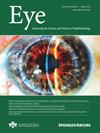Assessment of optical coherence tomography biomarkers in patients with non-neovascular age-related macular degeneration (AMD) converting to exudative AMD according to the status of the fellow eye
IF 3.2
3区 医学
Q1 OPHTHALMOLOGY
引用次数: 0
Abstract
To compare optical coherence tomography (OCT) biomarkers in eyes converting from non-neovascular (nnAMD) to exudative age-related macular degeneration (eAMD) based on the status of fellow eye. Retrospective analysis of one year of pre-conversion data of fellow eyes of patients with nnAMD and eAMD which converted to eAMD, defined as converting eyes (CE) with fellow nnAMD and CE with fellow eAMD respectively. Demographics, best corrected visual acuity (BCVA), and OCT biomarkers including drusen type, iRORA/cRORA, subfoveal ellipsoid zone (SFEZ) disruption, central macular thickness (CMT), subfoveal choroidal thickness (SFCT), Haller vascular thickness (HVT) were evaluated. Chi-square and t-tests were employed, confidence interval of 95% and p < 0.05. 72 eyes of 72 patients were included: 31 CE with fellow nnAMD and 41 CE with fellow eAMD. Mean age was 81.8 ± 9.9 years, with 62.5% females. Subfoveal iRORA was more frequent in CE with fellow nnAMD (26%) compared to CE with fellow eAMD (6%) 44 weeks before conversion (p = 0.058). SFCT and HVT were higher in CE with fellow nnAMD compared to CE with fellow eAMD 19 weeks prior to conversion (213 ± 82 vs. 174 ± 63 µm, p = 0.052; 121 ± 44 vs. 104 ± 50 µm, p = 0.084 respectively). BCVA was significantly higher in CE with fellow eAMD compared to CE with fellow nnAMD every time frame (p < 0.05). Although subtle distinctions, no significant differences were observed between the groups. Further research is needed to understand the influence of one eye’s status on progression from nnAMD to eAMD in fellow eye.

根据同侧眼的状况,评估非血管性老年性黄斑变性(AMD)转化为渗出性AMD患者的光学相干断层扫描生物标志物。
研究目的根据同侧眼的状况,比较从非新生血管性黄斑变性(nnAMD)转化为渗出性年龄相关性黄斑变性(eAMD)的眼的光学相干断层扫描(OCT)生物标志物:方法:回顾性分析nnAMD和eAMD患者同侧眼转换为eAMD前一年的数据,分别定义为同侧眼为nnAMD的转换眼(CE)和同侧眼为eAMD的转换眼(CE)。研究人员评估了患者的人口统计学特征、最佳矫正视力(BCVA)和 OCT 生物标记物,包括眼底色素类型、iRORA/cRORA、眼底椭圆形区(SFEZ)破坏、黄斑中心厚度(CMT)、眼底脉络膜厚度(SFCT)和霍勒血管厚度(HVT)。采用卡方检验和 t 检验,置信区间为 95% 和 p 结果:共纳入 72 名患者的 72 只眼睛:其中,31 位 CE 同时患有 nnAMD,41 位 CE 同时患有 eAMD。平均年龄为 81.8 ± 9.9 岁,女性占 62.5%。与同为 eAMD 的 CE(6%)相比,同为 nnAMD 的 CE(26%)眼底 iRORA 在转换前 44 周更为常见(p = 0.058)。与患有 eAMD 的 CE 相比,患有 nnAMD 的 CE 在转换前 19 周的 SFCT 和 HVT 更高(分别为 213 ± 82 vs. 174 ± 63 µm,p = 0.052;121 ± 44 vs. 104 ± 50 µm,p = 0.084)。与患有同侧 eAMD 的 CE 相比,患有同侧 nnAMD 的 CE 在每个时间段的 BCVA 都明显较高(p 结论):尽管存在细微差别,但各组之间未观察到明显差异。要了解一只眼的状态对同侧眼从 nnAMD 发展到 eAMD 的影响,还需要进一步的研究。
本文章由计算机程序翻译,如有差异,请以英文原文为准。
求助全文
约1分钟内获得全文
求助全文
来源期刊

Eye
医学-眼科学
CiteScore
6.40
自引率
5.10%
发文量
481
审稿时长
3-6 weeks
期刊介绍:
Eye seeks to provide the international practising ophthalmologist with high quality articles, of academic rigour, on the latest global clinical and laboratory based research. Its core aim is to advance the science and practice of ophthalmology with the latest clinical- and scientific-based research. Whilst principally aimed at the practising clinician, the journal contains material of interest to a wider readership including optometrists, orthoptists, other health care professionals and research workers in all aspects of the field of visual science worldwide. Eye is the official journal of The Royal College of Ophthalmologists.
Eye encourages the submission of original articles covering all aspects of ophthalmology including: external eye disease; oculo-plastic surgery; orbital and lacrimal disease; ocular surface and corneal disorders; paediatric ophthalmology and strabismus; glaucoma; medical and surgical retina; neuro-ophthalmology; cataract and refractive surgery; ocular oncology; ophthalmic pathology; ophthalmic genetics.
 求助内容:
求助内容: 应助结果提醒方式:
应助结果提醒方式:


